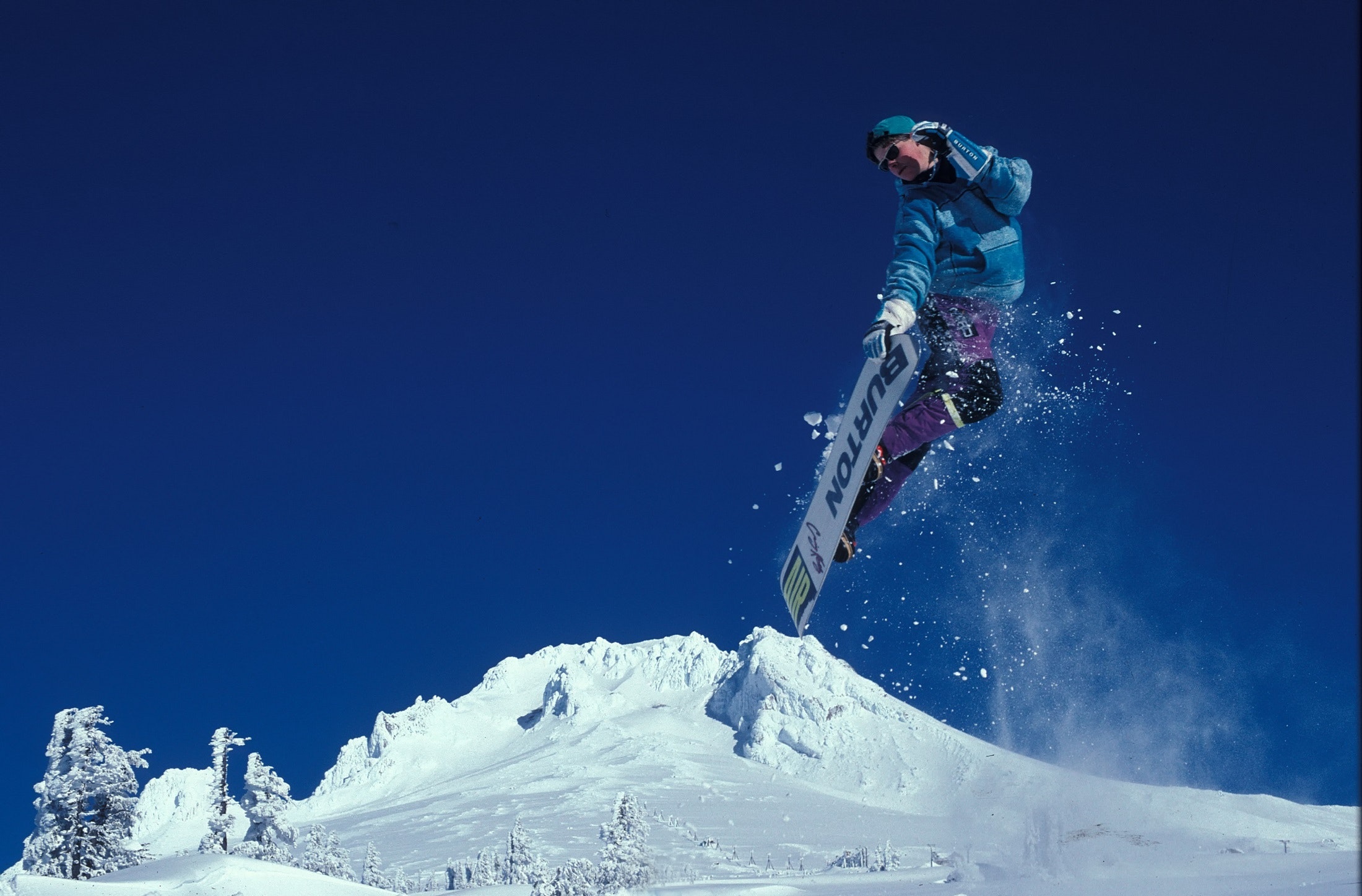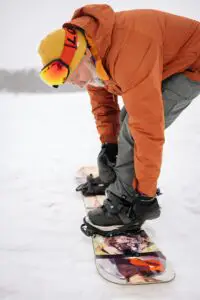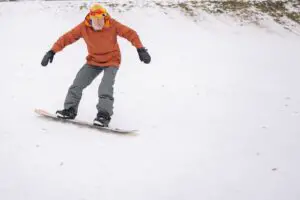Did you know that you can actually snowboard in the rain? Despite what some may think, rainy weather doesn’t mean you have to hang up your board. In fact, it can add an exciting twist to your riding experience.
With the right gear and techniques, you can still have a thrilling time on the slopes even when it’s wet outside. So grab your waterproof gear and get ready to shred the rain-soaked mountain!
Key Takeaways
- Riding on wet snow can be challenging due to the slick and unpredictable surface.
- Rain reduces visibility, making it harder to spot obstacles or changes in terrain.
- Wet conditions can slow down your speed and make your board feel heavier.
- Adjust your technique and approach to maintain balance on slippery slopes.
The Impact of Rain on Snowboarding Performance
You can still snowboard in the rain, but it may affect your performance. Riding on wet snow can be challenging, as the surface becomes slick and unpredictable. The rainwater creates a layer of slush that makes turns less responsive and slows down your speed. Your board may feel heavier due to water absorption, making it harder to control and maneuver.
Additionally, rain reduces visibility, which can make it difficult to spot obstacles or changes in terrain. It’s important to adjust your technique and approach when riding in the rain. Keep your weight centered and use softer movements to maintain balance on the slippery slopes.
Remember to wear appropriate gear like waterproof clothing and goggles for better comfort and protection. Despite these challenges, don’t let the rain dampen your spirits – adapt, enjoy the experience, and embrace the unique thrill of shredding through wet conditions!
Safety Tips for Snowboarding in Wet Conditions
When it’s wet out on the slopes, remember to always wear appropriate gear for maximum safety. Snowboarding in wet conditions can still be enjoyable and fun, but it’s important to take precautions to ensure your well-being.
Firstly, make sure you have a waterproof jacket and pants to keep yourself dry. Wet clothes can lead to discomfort and even hypothermia in extreme cases.
Secondly, wear goggles or a helmet with a visor to protect your eyes from raindrops or snowmelt that may impair your vision. Additionally, consider using gloves with good grip and traction on the palms for better control of your board.
Lastly, be mindful of your surroundings and adjust your riding style accordingly. Wet slopes can be slippery, so maintain a lower speed and focus on balance and stability.
Gear and Equipment for Rainy Snowboarding
When it comes to rainy snowboarding, there are a few key points to consider. First, it’s important to invest in high-quality waterproof clothing and gear. This includes jackets, pants, gloves, and boots that will keep you dry throughout your ride.
Secondly, ensuring good visibility is crucial. You can achieve this by wearing bright or reflective clothing. Additionally, using goggles with anti-fog lenses will help you see clearly even in wet and snowy conditions.
Lastly, don’t forget about safety. Make sure you have the proper equipment to protect yourself from potential injuries. This includes wearing helmets and wrist guards.
Waterproof Clothing and Gear
Wearing waterproof clothing and gear is essential for snowboarding in the rain. When you hit the slopes on a rainy day, you want to make sure you stay dry and comfortable throughout your ride.
Waterproof jackets, pants, and gloves are designed to keep water out while allowing moisture to escape, keeping you dry from both the rain and your own sweat. Look for materials like Gore-Tex or DWR (Durable Water Repellent) coatings that provide excellent water resistance.
Additionally, make sure your boots are also waterproof to keep your feet warm and dry. Don’t forget about goggles with anti-fog technology to maintain clear vision on those wet days.
With the right waterproof clothing and gear, you can confidently shred the slopes even when it’s raining!
Visibility and Safety
Make sure to wear high-visibility clothing and gear, such as brightly colored jackets and reflective accessories, to enhance your safety on the slopes. When it comes to snowboarding in any weather condition, including rain, visibility becomes even more crucial. Here are some reasons why wearing high-visibility gear is important:
- Increased visibility: Bright colors and reflective elements make it easier for others on the slopes to see you, reducing the risk of collisions.
- Easy identification: Standing out in a crowd can help your friends or instructors spot you quickly.
- Enhanced communication: Your bright attire allows for better visual communication with other snowboarders or ski patrol members.
- Safety precaution: Wearing high-visibility gear ensures that you are easily visible in case of an emergency.
Techniques for Maintaining Control in Wet Snow
If you find yourself snowboarding in wet conditions, there are a few tips that can help you maintain control on the slopes.
First, make sure to choose the right wax for your board to ensure optimal performance in wet snow.
Additionally, adjusting your stance and weight distribution can also improve stability and maneuverability.
Lastly, proper maintenance is crucial to prevent damage from moisture, so be sure to dry and store your snowboard correctly after riding in rainy weather.
Wet Snowboarding Tips
To improve your wet snowboarding experience, remember to keep your speed controlled and use shorter turns. Wet snow can be challenging to ride on, but with the right techniques, you can still have a great time on the slopes. Here are some tips to help you make the most out of your wet snowboarding adventure:
- Wax your board: Applying wax to the base of your board will help reduce friction on the wet surface.
- Stay low: By bending your knees and keeping a lower center of gravity, you’ll have better control over your movements.
- Use an aggressive edge: Carving into the snow with a sharp edge will give you more stability and traction in wet conditions.
- Be mindful of obstacles: Wet snow can hide rocks or other hazards, so stay alert and adjust your line accordingly.
Controlling in Rainy Conditions
When it’s raining, maintaining control on the slopes can be a bit more challenging. But don’t worry, you can still enjoy snowboarding in these conditions with a few tips and tricks up your sleeve.
First and foremost, make sure you have the right gear. A waterproof jacket and pants will keep you dry and comfortable throughout your ride. Additionally, choose a board with good edge grip to ensure stability on wet surfaces.
When riding in the rain, focus on maintaining balance and using controlled movements. Keep your weight centered over your board and avoid sudden turns or stops that could cause slips or slides. It’s also important to adjust your speed accordingly and give yourself plenty of space between other riders.
Snowboard Maintenance for Rain
Maintaining your snowboard during rainy conditions is crucial for optimal performance. Rain can have a significant impact on your board’s performance, so it’s essential to take the necessary steps to keep it in top shape.
Here are some tips to help you maintain your snowboard during rainy weather:
- Clean and dry: After riding in the rain, make sure to thoroughly clean your board and dry it completely. This will prevent rusting and ensure that no moisture is trapped.
- Inspect bindings: Check your bindings for any signs of damage or wear caused by the rain. Tighten any loose screws or replace damaged parts as needed.
- Wax regularly: Applying wax regularly helps protect your board from moisture and keeps it gliding smoothly on wet surfaces.
- Store properly: When not in use, store your snowboard in a dry place away from direct sunlight or extreme temperatures. This will help prolong its lifespan and maintain its performance.
How Rain Affects Snowboard Wax and Edges
Rain can cause the snowboard wax and edges to become less effective. When water comes into contact with your snowboard, it can wash away the protective layer of wax that helps you glide smoothly on the slopes. This can lead to reduced speed and control while riding.
Additionally, rainwater can seep into the pores of your board’s base, causing it to swell and become more porous over time. As a result, your board may absorb more moisture in future rides, making it heavier and less responsive.
The edges of your snowboard can also be affected by rain as they may rust or corrode if not properly dried afterwards. To prevent these issues, make sure to apply a fresh coat of wax before hitting the slopes after rain and thoroughly dry your board afterwards to maintain its performance and durability.
Benefits of Rainy Weather for Snowboarding
Even though it may seem counterintuitive, riding in rainy weather can actually enhance the performance of your snowboard. Rainy conditions offer unique benefits that can elevate your snowboarding experience. Here’s why:
- Improved Speed: Rainwater acts as a lubricant, reducing friction between your board and the snow. This allows you to glide effortlessly and achieve higher speeds.
- Enhanced Flexibility: The moisture from rain softens the snow surface, making it more forgiving for tricks and maneuvers. You’ll have better control over your board, allowing you to execute tricks with ease.
- Natural Terrain Features: Rain alters the shape of the slopes by creating ruts and bumps. These natural features provide additional challenges and opportunities for creativity on the mountain.
- Less Crowded Slopes: Many riders avoid rainy days, meaning you’ll have more space to explore without worrying about crowded runs.
Common Mistakes to Avoid When Snowboarding in the Rain
Don’t let the rainy weather ruin your snowboarding experience by making these common mistakes.
When it’s raining while you’re out on the slopes, it’s important to stay prepared and make smart decisions to ensure a fun and safe ride.
First off, make sure you have proper gear that is waterproof and insulated. This will keep you comfortable and dry throughout your day.
Additionally, be mindful of your visibility as rain can impair your vision. Consider wearing goggles with anti-fog coating or using a helmet with a visor to protect your eyes from water droplets.
Lastly, adjust your riding style accordingly by adopting a more controlled stance and reducing speed to maintain stability on wet surfaces.
Frequently Asked Questions
Will Snowboarding in the Rain Damage My Snowboard?
Snowboarding in the rain can potentially damage your snowboard. The moisture can seep into the core and weaken the board over time. It’s best to avoid riding in heavy rain or make sure your board is properly protected.
Can I Wear My Regular Snowboarding Gear in Rainy Conditions?
Yes, you can wear your regular snowboarding gear in rainy conditions. However, it’s important to choose waterproof or water-resistant outerwear and make sure your gear is properly maintained to ensure maximum comfort and protection.
How Does Rain Affect the Snow Conditions on the Slopes?
Rain can turn the slopes into a slippery and unpredictable terrain, affecting snow conditions. It can create slushy or icy patches, making it challenging to maintain control while snowboarding.
Are There Any Specific Techniques or Tricks to Improve Performance While Snowboarding in the Rain?
Yes, you can snowboard in the rain. It may affect the snow conditions, so it’s important to adjust your technique. Focus on maintaining balance, using shorter turns, and keeping your speed under control.
Can I Still Enjoy a Day of Snowboarding in the Rain, or Should I Consider Other Activities Instead?
You can definitely still enjoy a day of snowboarding in the rain! While it may affect the conditions and visibility, with proper gear and technique adjustments, you can have a thrilling time on the slopes.
Conclusion
So, can you snowboard in the rain? The answer is yes, but it comes with its challenges.
While rainy weather may impact your performance and make the slopes more slippery, there are safety tips and techniques you can use to maintain control.
Make sure you have the right gear and equipment for wet conditions, and be aware of how rain affects your board’s wax and edges.
Despite the obstacles, there are also some benefits to riding in the rain. Just remember to avoid common mistakes and stay alert on the slopes.
So next time it’s raining, don’t let it stop you from hitting the mountain!





